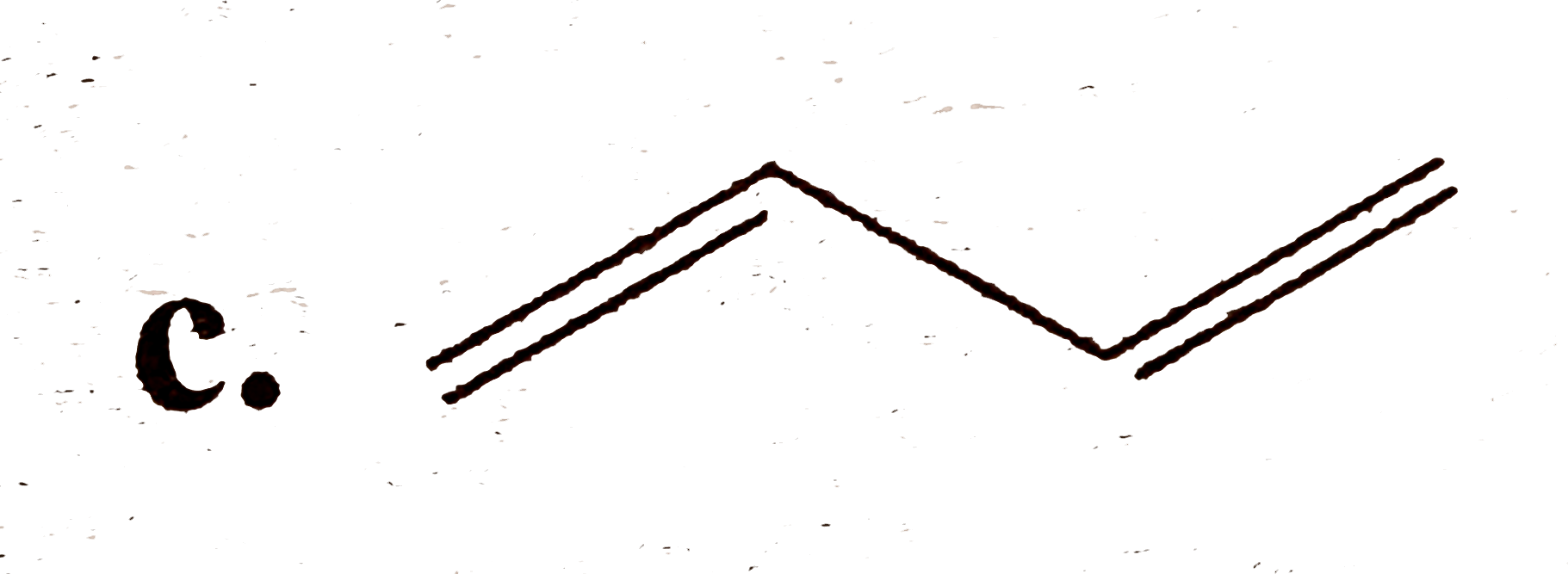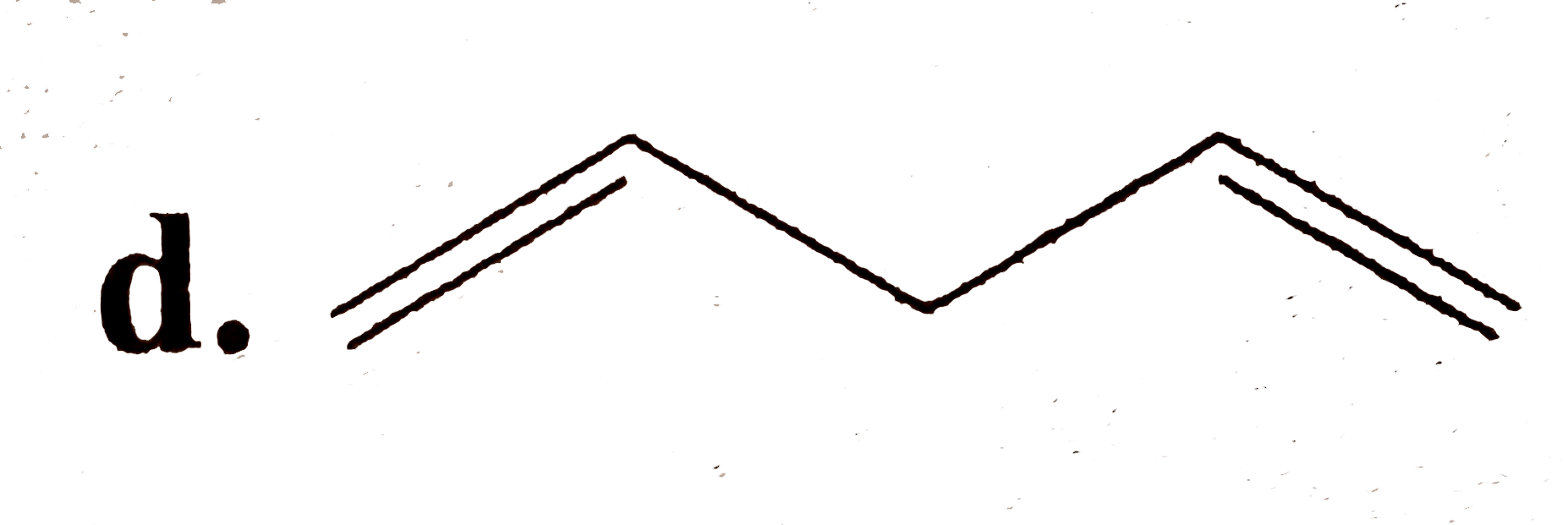Stabilities of alkanes can be compared by converting these compounds to a common product and comparing the amount of the heat given off. One possiblitiy would be to measure the heat of combustion from converting alkenes to xo2 and H2O . The heats of combustion are of large values and measuring small difference in these large numbers is difficult. Alkene of the lowest heat of combustion among isomeric alkenes is of the lowest energy and is most stable.
Th stability of alkenes is often compared by meansuring the ehat of hydrogenation 9 heat given off, ΔH∘h during catalytic hydrogenation. The heat of hydrogenation is in smal number, which provides more accurate energy difference.
For a compound containing more than one double bond, Δ∘h is the sum of heat of hydrogenation of individual double bonds. For non − conjugated diens, this additive relatioship is found to hold. For conjugated dienes, however, the measured value is slightly lower than expected. Cumulated dienes, which are even less stable than non − conjugated dienes.
The more stable is the alkene, lower is the heat of combustion and heat of hydrogenation. More highly substituted double bonds are usually more stable. In case of cyclokanes, compounds having higher angle strin are less stable.
Arrange the following compounds according to their increasing heat of combustion. I. 1−Butene
II. ci −2−Butene
III. trans −2−Butene
IV. 2− Methyl propene
(IV)>(I)<(II)<(III)
(I)<(II)<(IV)<(III)
(IV)>(III)<(II)<(I)
(I)<(II)<(III)<(IV)
The correct Answer is:c
To determine the increasing heat of combustion of the given alkenes, we need to analyze their stability based on the information provided in the question and the video transcript. The stability of alkenes is influenced by the degree of substitution of the double bond: more substituted alkenes are generally more stable and thus have lower heats of combustion.
1. Identify the Compounds:
- I. 1-Butene (CH2=CH-CH2-CH3)
- II. cis-2-Butene (CH3-CH=CH-CH3 with both methyl groups on the same side)
- III. trans-2-Butene (CH3-CH=CH-CH3 with methyl groups on opposite sides)
- IV. 2-Methylpropene (C(CH3)2=CH2)
2. Determine the Degree of Substitution:
- 1-Butene is a monosubstituted alkene (1 substituent).
- cis-2-Butene is a disubstituted alkene (2 substituents).
- trans-2-Butene is also a disubstituted alkene (2 substituents).
- 2-Methylpropene is a trisubstituted alkene (3 substituents).
3. Rank the Stability:
- The stability order based on substitution is:
- 2-Methylpropene (most stable, lowest heat of combustion)
- trans-2-Butene (more stable than cis due to less steric strain)
- cis-2-Butene
- 1-Butene (least stable, highest heat of combustion)
4. Assign the Heats of Combustion:
- Since more stable alkenes have lower heats of combustion, we can assign the heats of combustion in increasing order:
- 2-Methylpropene (lowest heat of combustion)
- trans-2-Butene
- cis-2-Butene
- 1-Butene (highest heat of combustion)
5. Final Arrangement:
- Therefore, the increasing order of heat of combustion is:
- IV (2-Methylpropene) < III (trans-2-Butene) < II (cis-2-Butene) < I (1-Butene)
Conclusion:
The final arrangement according to increasing heat of combustion is:
IV < III < II < I
- I. 1-Butene (CH2=CH-CH2-CH3)
- II. cis-2-Butene (CH3-CH=CH-CH3 with both methyl groups on the same side)
- III. trans-2-Butene (CH3-CH=CH-CH3 with methyl groups on opposite sides)
- IV. 2-Methylpropene (C(CH3)2=CH2)
- 1-Butene is a monosubstituted alkene (1 substituent).
- cis-2-Butene is a disubstituted alkene (2 substituents).
- trans-2-Butene is also a disubstituted alkene (2 substituents).
- 2-Methylpropene is a trisubstituted alkene (3 substituents).
- The stability order based on substitution is:
- 2-Methylpropene (most stable, lowest heat of combustion)
- trans-2-Butene (more stable than cis due to less steric strain)
- cis-2-Butene
- 1-Butene (least stable, highest heat of combustion)
- Since more stable alkenes have lower heats of combustion, we can assign the heats of combustion in increasing order:
- 2-Methylpropene (lowest heat of combustion)
- trans-2-Butene
- cis-2-Butene
- 1-Butene (highest heat of combustion)
- Therefore, the increasing order of heat of combustion is:
- IV (2-Methylpropene) < III (trans-2-Butene) < II (cis-2-Butene) < I (1-Butene)
The final arrangement according to increasing heat of combustion is:
IV < III < II < I
Topper's Solved these Questions
- ALKENES AND ALKADIENESBOOK - CENGAGE CHEMISTRYCHAPTER - ALKENES AND ALKADIENESEXERCISE - Multiple Correct Answer Type
41 Videos
- ALKENES AND ALKADIENESBOOK - CENGAGE CHEMISTRYCHAPTER - ALKENES AND ALKADIENESEXERCISE - Single Correct Answer Type
62 Videos
- ALKENES AND ALKADIENESBOOK - CENGAGE CHEMISTRYCHAPTER - ALKENES AND ALKADIENESEXERCISE - EXERCISES
29 Videos
- ALKANES AND CYCLOALKANESBOOK - CENGAGE CHEMISTRYCHAPTER - ALKANES AND CYCLOALKANESEXERCISE - Archives
13 Videos
- ALKYNESBOOK - CENGAGE CHEMISTRYCHAPTER - ALKYNESEXERCISE - Exercises (Archives - Analytical and Desriptive Type)
4 Videos
Similar Questions
Stabilities of alkanes can be compared by converting these compounds to a common product and comparing the amount of the heat given off. One possiblitiy would be to measure the heat of combustion from converting alkenes to xo2 and H2O . The heats of combustion are of large values and measuring small difference in these large numbers is difficult. Alkene of the lowest heat of combustion among isomeric alkenes is of the lowest energy and is most stable.
Th stability of alkenes is often compared by meansuring the ehat of hydrogenation 9 heat given off, ΔH∘h during catalytic hydrogenation. The heat of hydrogenation is in smal number, which provides more accurate energy difference.
For a compound containing more than one double bond, Δ∘h is the sum of heat of hydrogenation of individual double bonds. For non − conjugated diens, this additive relatioship is found to hold. For conjugated dienes, however, the measured value is slightly lower than expected. Cumulated dienes, which are even less stable than non − conjugated dienes.
The more stable is the alkene, lower is the heat of combustion and heat of hydrogenation. More highly substituted double bonds are usually more stable. In case of cyclokanes, compounds having higher angle strin are less stable.
If the heat of hydrogenation of cyclooctene is about 23kcalmo−1, what would be the probable ΔHb or 1,3,5,7−cyclooctatetraene ?
View SolutionThe heat of combustion is
View Solution
Knowledge Check
Stabilities of alkanes can be compared by converting these compounds to a common product and comparing the amount of the heat given off. One possiblitiy would be to measure the heat of combustion from converting alkenes to xo2 and H2O . The heats of combustion are of large values and measuring small difference in these large numbers is difficult. Alkene of the lowest heat of combustion among isomeric alkenes is of the lowest energy and is most stable.
Th stability of alkenes is often compared by meansuring the ehat of hydrogenation 9 heat given off, ΔH∘h during catalytic hydrogenation. The heat of hydrogenation is in smal number, which provides more accurate energy difference.
For a compound containing more than one double bond, Δ∘h is the sum of heat of hydrogenation of individual double bonds. For non − conjugated diens, this additive relatioship is found to hold. For conjugated dienes, however, the measured value is slightly lower than expected. Cumulated dienes, which are even less stable than non − conjugated dienes.
The more stable is the alkene, lower is the heat of combustion and heat of hydrogenation. More highly substituted double bonds are usually more stable. In case of cyclokanes, compounds having higher angle strin are less stable.
The wrong option among the following statements is :AThe decreasing order of the value of the heat of combustion is :
 BCycloalkanes are planarCCyclopropane has a higher heat of combustion per methylene group (CH2) than of cyclobutane.DWith the exception of cyclpropane, cycloalkanes are non− planar.
BCycloalkanes are planarCCyclopropane has a higher heat of combustion per methylene group (CH2) than of cyclobutane.DWith the exception of cyclpropane, cycloalkanes are non− planar.Stabilities of alkanes can be compared by converting these compounds to a common product and comparing the amount of the heat given off. One possiblitiy would be to measure the heat of combustion from converting alkenes to xo2 and H2O . The heats of combustion are of large values and measuring small difference in these large numbers is difficult. Alkene of the lowest heat of combustion among isomeric alkenes is of the lowest energy and is most stable.
Th stability of alkenes is often compared by meansuring the ehat of hydrogenation 9 heat given off, ΔH∘h during catalytic hydrogenation. The heat of hydrogenation is in smal number, which provides more accurate energy difference.
For a compound containing more than one double bond, Δ∘h is the sum of heat of hydrogenation of individual double bonds. For non − conjugated diens, this additive relatioship is found to hold. For conjugated dienes, however, the measured value is slightly lower than expected. Cumulated dienes, which are even less stable than non − conjugated dienes.
The more stable is the alkene, lower is the heat of combustion and heat of hydrogenation. More highly substituted double bonds are usually more stable. In case of cyclokanes, compounds having higher angle strin are less stable.
Which statement is false ?AHydrogenation is an exothermic reaction.BHeat of hydrogenation is better than heat of combustion for meansuring the stabilities of alkenes.CAmong the isomers alkene, the most stable alkene has the lowes heat of hydrogenation and the highest heat of combustion.DAmong the isomeric alkenes, the most stable alkenne has the lowest value of heat of hydrogenation and heat of combustionStabilities of alkanes can be compared by converting these compounds to a common product and comparing the amount of the heat given off. One possiblitiy would be to measure the heat of combustion from converting alkenes to xo2 and H2O . The heats of combustion are of large values and measuring small difference in these large numbers is difficult. Alkene of the lowest heat of combustion among isomeric alkenes is of the lowest energy and is most stable.
Th stability of alkenes is often compared by meansuring the ehat of hydrogenation 9 heat given off, ΔH∘h during catalytic hydrogenation. The heat of hydrogenation is in smal number, which provides more accurate energy difference.
For a compound containing more than one double bond, Δ∘h is the sum of heat of hydrogenation of individual double bonds. For non − conjugated diens, this additive relatioship is found to hold. For conjugated dienes, however, the measured value is slightly lower than expected. Cumulated dienes, which are even less stable than non − conjugated dienes.
The more stable is the alkene, lower is the heat of combustion and heat of hydrogenation. More highly substituted double bonds are usually more stable. In case of cyclokanes, compounds having higher angle strin are less stable.
In which of the following is ΔH_(h)∘ the maximum ?AH2C=CH2BH2C=C=CH2C D
D
The heat of combustion of a compound
View SolutionThe enthalpy combustion of a substance
View SolutionArrange the following compounds in decreasing order of their heats of combustion:

View SolutionThe gas with the highest heat of combustion is :
View SolutionWhich one of the following has loqest heat of combustion ?
View Solution
